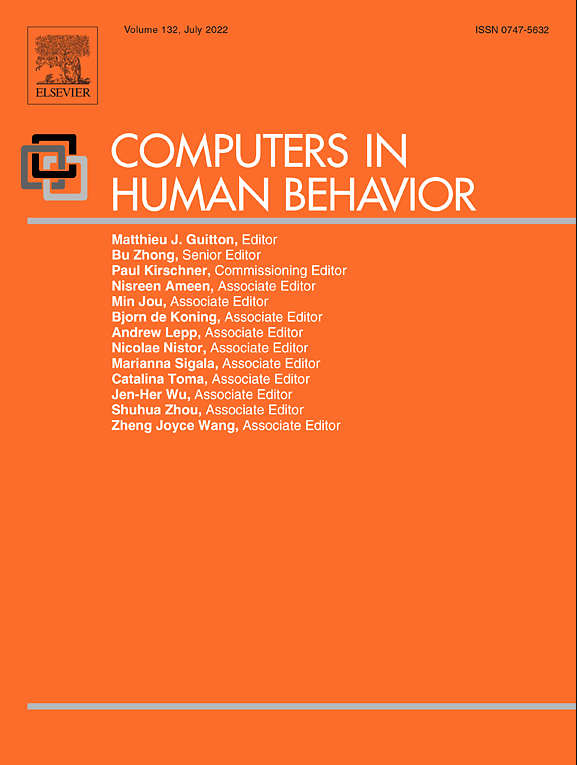Editorial Board
Digital Nativity and Information Technology Addiction: Age cohort versus individual difference approaches
Social anxiety in the digital age: The measurement and sequelae of online safety-seeking
Social distraction? Social media use and political knowledge in two U.S. Presidential elections
Assessing binge-watching behaviors: Development and validation of the “Watching TV Series Motives” and “Binge-watching Engagement and Symptoms” questionnaires
A virtual reality based study of indoor fire evacuation after active or passive spatial exploration
Startup founders and their LinkedIn connections: Are well-connected entrepreneurs more successful?
The relationship between cell phone use, physical activity, and sedentary behavior in adults aged 18–80
Seniors' usage of mobile social network sites: Applying theories of innovation diffusion and uses and gratifications
Child neglect, psychological abuse and smartphone addiction among Chinese adolescents: The roles of emotional intelligence and coping style
Parenting in the digital era: Protective and risk parenting styles for traditional bullying and cyberbullying victimization
“I'd like to be under the sea”: Contextual cues in virtual environments influence the orientation of idea generation
Exploring the buffer effect of receiving social support on lonely and emotionally unstable social networking users
Embedded instruction to learn information problem solving: Effects of a whole task approach
Lurking towards empowerment: Explaining propensity to engage with online health support groups and its association with positive outcomes
Internet use and job satisfaction
Exploring the emotional antecedents and outcomes of technology acceptance
The impacts of motivational framing of technology restrictions on adolescent concealment: Evidence from a preregistered experimental study
A hybrid modeling approach for predicting the educational use of mobile cloud computing services in higher education
The impact of a social media literacy intervention on positive attitudes to tanning: A pilot study
Does persistent involvement in media and technology lead to lower academic performance? Evaluating media and technology use in relation to multitasking, self-regulation and academic performance
A pilot study on evaluating children with autism spectrum disorder using computer games
Marketing AI recruitment: The next phase in job application and selection
Behavioral consequences of Pokémon GO: The exaggerated picture
Mobile ubiquity: Understanding the relationship between cognitive absorption, smartphone addiction and social network services
Taking it to the next level: The negligible role of trust when online dating goes offline
Trust in online hotel reviews across review polarity and hotel category
Peer contagion processes for problematic internet use among Chinese college students: A process model involving peer pressure and maladaptive cognition
Erratum to “Explaining Cyberloafing: The Role of the Theory of Planned Behavior” [Computers in Human Behavior 36C 510–519]
Searching for questions, original thoughts, or advancing theory: Human-machine communication
Negotiated and reciprocal exchange structures in human-agent cooperation
What kind of news gatekeepers do we want machines to be? Filter bubbles, fragmentation, and the normative dimensions of algorithmic recommendations
Initial expectations, interactions, and beyond with social robots
Should AI-Based, conversational digital assistants employ social- or task-oriented interaction style? A task-competency and reciprocity perspective for older adults
Emotional processes in human-robot interaction during brief cognitive testing
Voices in and of the machine: Source orientation toward mobile virtual assistants
Robotic foot-in-the-door: Using sequential-request persuasive strategies in human-robot interaction
Evaluations of an artificial intelligence instructor's voice: Social Identity Theory in human-robot interactions
A perceived moral agency scale: Development and validation of a metric for humans and social machines
Exploring retention and behavioral intentions when using social robotics to communicate a weather risk
Unpacking the black box: Examining the (de)Gender categorization effect in human-machine communication
Virtual prognostication: When virtual alcohol choices predict change in alcohol consumption over 6-months
Dominant and submissive nonverbal behavior of virtual agents and its effects on evaluation and negotiation outcome in different age groups

